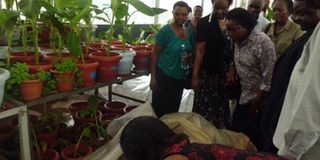Acceptance of GM crops spreads as agricultural challenges increase

Women MPs look at GM banana plantlets on sensitisation tour of agricultural institutes. While there have successes in research, the law to regulate biotechnology in Uganda is still before Parliament. FILE PHOTO
The Kenyan government is considering lifting the ban on genetically modified organisms (GMOs), which will probably be this month.
Previously, the Deputy President, William Ruto, made the announcement at the fourth Annual Biosafety Conference organised by the Kenya National Biosafety Authority (NBA) in Nairobi.
“Mark my words, in a matter of a month or two, we should be out of the ban,” he said. “I want to allay any fear from any quarter that there will be any attempt to roll back what has already been achieved and to give our undertaking to the scientific community in Kenya that you have support by the government of Kenya in facilitating the work you are doing.”
Ruto pointed out the dwindling cotton sector, climate change, pests and diseases attack on staple crops like maize as some of the areas where biotechnology can offer a solution.
Kenya had banned GMO products in 2011 when the then Public Health Minister, Beth Mugo, expressed fears over the safety of their consumption.
Ironic
It will be the fifth African country to introduce cultivation of GM crops after South Africa, Burkina Faso, Egypt, and Sudan.
Kenya is about to lift the ban on GMOs while Uganda is yet to pass the National Biotechnology and Biosafety Bill.
The delay may be unnecessary delay since government has been supporting biotechnology research at agricultural research institutions for donkey’s years.
It has set up laboratories, and trained scientists and paid them. Yet, ironically, the government is taking its time to put in place a law to regulate implementation of the results of their research.
Kenya’s decision to open its doors to the importation of GM products and to support cultivation of GM crops has however been criticised by some organisations such as Slow Food and environmentalist associations as well as a few local food producers. The claim is the introduction of GMOs will cause contamination of locally grown crops.
John Kariuki, who coordinates Slow Food activities in Kenya, has said, “This decision is threatening local agro-biodiversity.” In his view, even if GMOs improve yields, the problem of food shortage will persist.
Successes
An important observation to make is that Uganda has more reason than Kenya to resort to biotechnology in search of a solution to its agricultural challenges.
Two of Uganda’s major food crops, cassava and bananas, are facing extinction thanks to the Banana Bacterial Wilt, Cassava Mosaic, and Cassava Brown Streak Disease all of which have proven impossible to eradicate with the use of pesticides and ordinary control measures.
However, Ugandan scientists have made successes and come up with disease-resistant varieties. They have also been able to generate banana varieties enhanced with iron and Vitamin A to address malnutrition.
They are also working on drought-tolerant maize varieties with remarkable achievements.
Successful GM research has also been undertaken on resistance to cassava mosaic and cassava brown streak virus diseases.
Sadly, however, as the diseases continue to spread and reduce food production, and as the population suffers from the effects of malnourishment, the Parliament is dragging its feet in passing the regulatory law to enable the varieties to reach the farmers.
Our southern neighbour, Tanzania, also supports biotechnology as a sound approach to its agricultural problems.
Speaking in Dar es Salaam on June 16, Godfrey Zambi, the Assistant Minister for Agriculture, Food Security and Cooperatives, said that Tanzania cannot afford to ignore the benefits of biotechnology in developing various sectors of the economy, especially in agriculture. He was officiating at the launch of the ISAAA report on status of commercialised biotech crops.
Population vs food
In an article written by Nina Fedoroff, former advisor to US Secretary of State, in Agriculture and Food Security journal, she stated “GM crops are arguably the safest new crops ever introduced into the human and animal food chains. The overwhelming evidence is that the GM foods now on the market are as safe as or safer than non-GM foods.”
She brings into perspective the human population, which has increased sevenfold in the last two centuries.
Therefore, against FAO estimates that food production has to increase by 70 per cent by 2050 to meet the needs of the risen population, the current crop yield growth trends are insufficient to keep up with growing demand—more crops must be grown with the same amount of water, energy, and chemicals.
Move forward
In the case of Uganda, which has one of the highest fertility rates in Africa, it is not just its population that has sharply increased but its food crops are drastically reducing.
Another fact to highlight the impact of climate change on agriculture and what some countries miss by their refusal to adopt GM technology.
As Fedoroff sums it up: “More than 90% of farmers growing biotech crops today are smallholder and resource-poor. Twenty years of growing GM crops have reduced pesticide use by 37 per cent, increased crop yields by 22 per cent and increased farmers profits by 68 per cent. The simple reasons that farmers migrate to GM crops are that their yields increase and their costs decrease.”
This is the point to note as we try to find out the best way to move forward on this important issue.
The numbers: status of gm/biotechnology
Globally, a total of 28 countries in the world—20 developing and eight industrial countries—planted biotech crops in 2014 according to the ISAAA (International Service for the Acquisition of Agri-Biotech Applications). The hectares under biotech crops has increased a hundred-fold, from 1.7 million in 1996 to 181.5 million in 2014.
This increase makes biotech crops the fastest adopted crop technology in recent times.
The number of countries has more than quadrupled from six in1996 to 28 in 2014.




